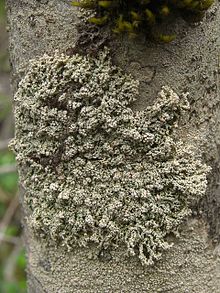
The Pannariaceae are a family of lichens in the order Peltigerales. Species from this family have a widespread distribution, but are especially prevalent in southern temperate regions.
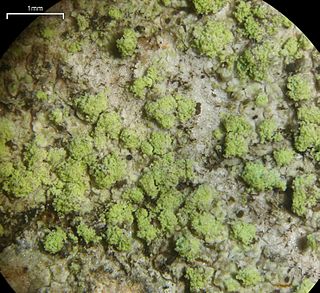
Biatora is a genus of lichens in the family Ramalinaceae. First described in 1817, the genus consists of crustose and squamulose lichens with green algal photobionts, biatorine apothecia, colorless, simple to 3-septate ascospores, and bacilliform pycnospores. According to the Dictionary of the Fungi, the genus contains 42 species that are widely distributed in temperate areas.
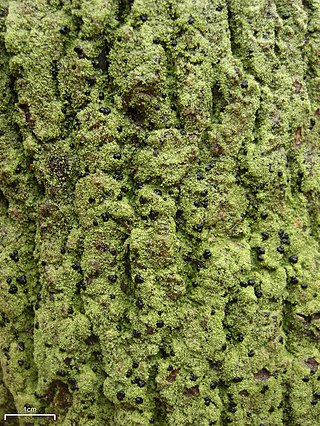
Bacidia is a genus of lichen-forming fungi in the family Ramalinaceae. The genus was circumscribed by Giuseppe De Notaris in 1846.

Ochrolechia is a genus of crustose lichens in the family Ochrolechiaceae.

Cliostomum is a genus of lichenized fungi in the family Ramalinaceae. It has about 25 species.

Miriquidica is a genus of lichen in the family Lecanoraceae. The genus was circumscribed in 1987 by lichenologists Hannes Hertel and Gerhard Rambold, with Miriquidica complanata assigned as the type species. According to Dictionary of the Fungi, the widespread genus contains 23 species, found predominantly in arctic-alpine regions.
Sagiolechia is a genus of lichen-forming fungi in the family Sagiolechiaceae. The genus was circumscribed by lichenologist Abramo Bartolommeo Massalongo in 1854, who assigned Sagiolechia protuberans as the type species. The family Sagiolechiaceae was proposed in 2010 to contain Sagiolechia as the type genus, and genus Rhexophiale; molecular phylogenetic analysis showed that these two genera formed a distinct clade in the Ostropales.
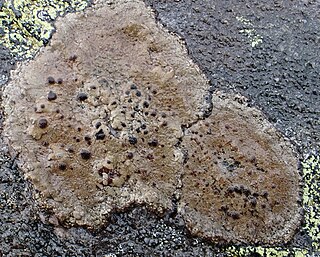
Fuscideaceae is a family of lichen-forming fungi in the order Umbilicariales. It contains five genera and about 55 species of crustose lichens.

Porpidia is a genus of crustose lichens in the family Lecideaceae.

Rhizocarpon is a genus of crustose, saxicolous, lecideoid lichens in the family Rhizocarpaceae. The genus is common in arctic-alpine environments, but also occurs throughout temperate, subtropical, and even tropical regions. They are commonly known as map lichens because of the prothallus forming border-like bands between colonies in some species, like the common map lichen.
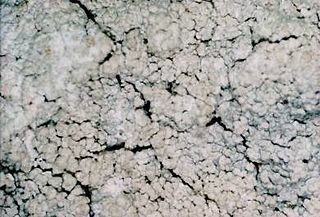
Lepraria is a genus of leprose crustose lichens that grows on its substrate like patches of granular, caked up, mealy dust grains. Members of the genus are commonly called dust lichens. The main vegetative body (thallus) is made of patches of soredia. There are no known mechanisms for sexual reproduction, yet members of the genus continue to speciate. Some species can form marginal lobes and appear squamulose. Because of the morphological simplicity of the thallus and the absence of sexual structures, the composition of lichen products are important characters to distinguish between similar species in Lepraria.

Notoparmelia is a genus of foliose lichens in the family Parmeliaceae. It includes 18 species that grow on bark and rocks, and are mostly distributed in the Southern Hemisphere. The genus was created in 2014 as a segregate of Parmelia.

Corticifraga is a genus of lichenicolous fungi in the family Gomphillaceae. The genus was circumscribed by David Leslie Hawksworth and Rolf Santesson in 1990, with Corticifraga peltigerae assigned as the type species.

Schaereria is a genus of lichen-forming fungi. It is the sole genus in the family Schaereriaceae, which itself is the only family in the Schaereriales, an order in the subclass Ostropomycetidae of the class Lecanoromycetes. Most Schaereria species are crustose lichens that live on rocks. Schaereria was first proposed by Gustav Wilhelm Körber in 1855 and was later taken up by other lichenologists despite periods of disuse.

Halecania is a genus of fungi in the family Leprocaulaceae. It has 22 species. The genus was circumscribed by Austrian lichenologist Michaela Mayrhofer in 1987, with Halecania alpivaga assigned as the type species. She created Halecania to contain species, formerly placed in Lecania, with the following characteristics: uniformly amyloid apical domes, paraphyses with dark brown apical caps, and halonate ascospores.

Lambiella is a genus of lichen-forming fungi in the family Xylographaceae. The genus was circumscribed by German botanist Hannes Hertel in 1984, with Lambiella psephota assigned as the type species.
Steineropsis is a genus of lichen-forming fungi in the family Pannariaceae. It has two species. The genus was circumscribed by Toby Spribille and Lucia Muggia in 2010, with Steineropsis alaskana assigned as the type species. The type specimen of this lichen was found in Skagway, Alaska, where it was growing on a rock in a snowbed at an altitude of 1,051 m (3,448 ft). The generic name alludes to a resemblance to the genus Steinera. A second species, Steineropsis laceratula, also found in Alaska, was added to the genus in 2020. Molecular phylogenetic analysis showed that Steineropsis has a sister taxon relationship to genus Protopannaria.
Atrophysma is a fungal genus in the family Pannariaceae. It contains the single species Atrophysma cyanomelanos, a crustose lichen found only in Alaska.
